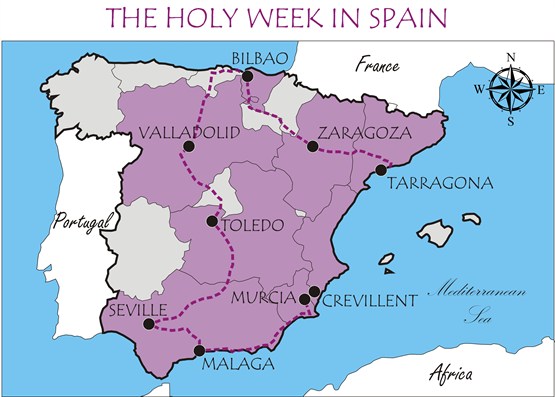The Holy Week in Spain
 Holy Week in Spain is a series of images, sounds and performances on the Passion, Death and Resurrection of Christ, which has few equals in the world. Only the Easter rites that take place in southern Italy and in Latin America, in fact, are comparable, in terms of antiquity, complexity and magnificence with the ceremonies in Spain. The representations of the Spanish Holy Week have their roots in the tradition of medieval misteri (mysteries), which included the staging of sacred subjects interpreted by living characters. Even today, for example, in Spain as in Italy, the pageants that parade during the processions of Corpus Christi are called misteri. In the Early Modern age, especially after the Counter-Reformation, these representations have given way to the more composed processions in which the Passion of Christ was re-enacted with the help of statues and groups of statues in wood. Known in Italy as Vare or misteri, in Spain the pageants of the Passion are called pasos (Seville, Zaragoza, Valladolid, Murcia), with the exception of Málaga, where they are called tronos. It is interesting to know that the twenty pasos carried in procession during the procession of the Santo Entierro (Holy Burial) of Tarragona are also known as the Mysteries.
Holy Week in Spain is a series of images, sounds and performances on the Passion, Death and Resurrection of Christ, which has few equals in the world. Only the Easter rites that take place in southern Italy and in Latin America, in fact, are comparable, in terms of antiquity, complexity and magnificence with the ceremonies in Spain. The representations of the Spanish Holy Week have their roots in the tradition of medieval misteri (mysteries), which included the staging of sacred subjects interpreted by living characters. Even today, for example, in Spain as in Italy, the pageants that parade during the processions of Corpus Christi are called misteri. In the Early Modern age, especially after the Counter-Reformation, these representations have given way to the more composed processions in which the Passion of Christ was re-enacted with the help of statues and groups of statues in wood. Known in Italy as Vare or misteri, in Spain the pageants of the Passion are called pasos (Seville, Zaragoza, Valladolid, Murcia), with the exception of Málaga, where they are called tronos. It is interesting to know that the twenty pasos carried in procession during the procession of the Santo Entierro (Holy Burial) of Tarragona are also known as the Mysteries.
The Spanish Holy Week is distinguished by the impressive number of confraternities and pasos that take part in it. These associations and groups of statues generally have very storied origins, often dating from the Baroque age. Spanish protocol is extremely rigid, to the point that in some cities special bodies have been set up to control and regulate the conduct of processions. The brothers who parade during the Holy Week are distinguished from one another through the multifaceted clothing and because of the role they play during the procession. In addition to those who carry the pasos on their shoulders, there are, for example, brothers entrusted with the traditional percussion instruments that set the pace of the processions. Every confraternity proudly displays its signs and symbols. Unlike Italy, where pageants recall all the main scenes of the Passion, the sacred processions in Spain are mainly focused on the repetitive and exhausting comparison of Christ and the Virgin, between the image of martyrdom of that of pain.
An exception is, for example, the Procession of the Santo Entierro of Zaragoza, during which you can watch a complete representation of the Passion of Christ. This, as we have said, seldom happens in Spain, where it is more common to attend individual processions distributed in the whole of Holy Week, or within the same day. In most cases, therefore, we witness a partial representation (since they all evoke by scenes from the Way of the Cross), which is repetitive (because each confraternity brings the same pair of pasos in procession, that of Jesus Christ and the Virgin Mary) and interminable (since one witnesses a obsessive and reiterated confrontation between the Mother and the Son).
In the most important processions in Spain, despite their being expected to attend in costume (as in the case of the participants of the Armats on Holy Friday in Tarragona), the Passion of Christ is told primarily through the use of statuary groups. In Italy, however, there are not only examples of processions with live people, but there is also a very widespread tradition of representing the last days of Jesus through the display of the symbols of his martyrdom.
